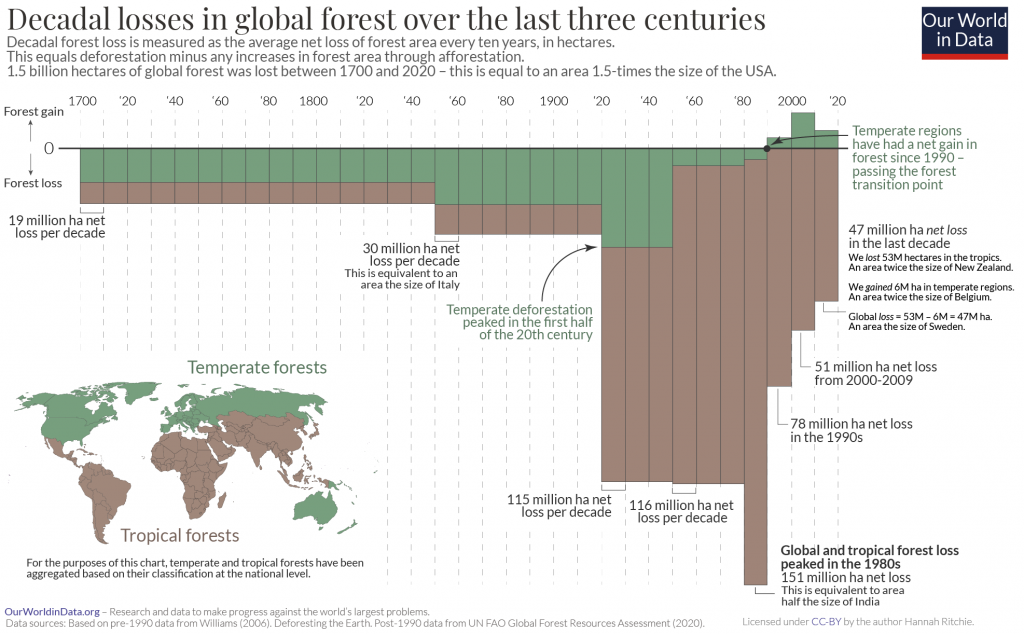How Sustainable Is MDF Wood (Medium-Density Fibreboard)? Here Are the Facts
Impactful Ninja is reader-supported. When you buy through links on our site, we may earn an affiliate commission.
Learn more
Learn more
.
Hey fellow impactful ninja ? You may have noticed that Impactful Ninja is all about providing helpful information to make a positive impact on the world and society. And that we love to link back to where we found all the information for each of our posts. Most of these links are informational-based for you to check out their primary sources with one click. But some of these links are so-called "affiliate links" to products that we recommend. First and foremost, because we believe that they add value to you. For example, when we wrote a post about the environmental impact of long showers, we came across an EPA recommendation to use WaterSense showerheads. So we linked to where you can find them. Or, for many of our posts, we also link to our favorite books on that topic so that you can get a much more holistic overview than one single blog post could provide. And when there is an affiliate program for these products, we sign up for it. For example, as Amazon Associates, we earn from qualifying purchases. First, and most importantly, we still only recommend products that we believe add value for you. When you buy something through one of our affiliate links, we may earn a small commission - but at no additional costs to you. And when you buy something through a link that is not an affiliate link, we won’t receive any commission but we’ll still be happy to have helped you. When we find products that we believe add value to you and the seller has an affiliate program, we sign up for it. When you buy something through one of our affiliate links, we may earn a small commission (at no extra costs to you). And at this point in time, all money is reinvested in sharing the most helpful content with you. This includes all operating costs for running this site and the content creation itself. You may have noticed by the way Impactful Ninja is operated that money is not the driving factor behind it. It is a passion project of mine and I love to share helpful information with you to make a positive impact on the world and society. However, it's a project in that I invest a lot of time and also quite some money. Eventually, my dream is to one day turn this passion project into my full-time job and provide even more helpful information. But that's still a long time to go. Stay impactful,Affiliate Disclosure
Why do we add these product links?
What do these affiliate links mean for you?
What do these affiliate links mean for us?
What does this mean for me personally?
![]()
Medium-Density Fiberboard (MDF) was born from leftover wood chips and shavings. This engineered wood is an excellent way to recycle waste material collected from sawmills. However, the chemicals used in glues that necessitate the formation of these boards are a cause for concern. So we had to ask: How sustainable is it to buy products made out of red oak wood?
MDF’s sustainability depends on its components: wood and glues. Using wood waste further benefits the environment because trees uptake carbon and mitigate climate change. But, because of synthetic adhesives, MDF is not biodegradable and has no carbon-offset value. Also, some glues emit toxic gases.
In this article, we’ll walk you through the life-cycle of MDF (Medium-Density Fiberboard) used for furniture and flooring. Then, we evaluate its sustainability, potential, and shortfalls. And in the end, we’ll show you tips for buying sustainable MDF.
Here’s How Sustainable MDF Wood (Medium-Density Fibreboard) Is
MDF (Medium-Density Fibreboard) panels could be made and consumed sustainably if manufacturers source environmentally friendly components and consumers arrange to recycle MDF furniture properly. Wood is mostly a sustainable material because of timber trees’ carbon sequestration potential. And using wood waste increases the material’s environmental benefits. Though most glues contain toxic chemicals, there are natural-based bonding alternatives, which are more environmentally friendly.
“Sustainable: The ability to be maintained at a certain rate or level | Avoidance of the depletion of natural resources in order to maintain an ecological balance”
Oxford Dictionary
To understand the sustainability of MDF, we assess the life-cycle of MDF furniture and household items. This life-cycle assessment (LCA) is a method to evaluate the environmental impacts of each stage in a product’s life-cycle, from the making to the recycling. Over the years, companies have strategically used LCA to research and create more sustainable products.
In this article, we’ll use the cradle-to-grave perspective of the LCA, examining the five stages of the life-cycle of furniture and flooring made with MDF panels. However, you will also find some cradle-to-gate data where relevant.
| The life-cycle stages of MDF panels | Each stage’s sustainability |
| Sourcing of MDF components | Sourcing waste material for MDF panels can be sustainable thanks to timber trees’ carbon sequestration and the utilization of chips and shavings in sawmills. On the other hand, glue raises environmental concerns as commonly-used resins used in MDF panels contain toxic chemicals. However, natural-based bonding alternatives can be used to make MDF wood more environmentally friendly. |
| Manufacturing of MDF | Manufacturing MDF panels can have a significant carbon footprint due to the energy needed to run machinery to process the wood waste and make the resin. |
| Transporting of MDF components | Transporting can be another carbon-intensive stage in the life-cycle of MDF furniture due to the emissions associated with operating the hauling vehicles. Transporting points include taking timber to sawmills, delivering wood waste to MDF factories, then bringing MDF furniture to stores. MDF panels made with wood waste from local sawmills have a lower carbon footprint than MDF panels containing imported woods, providing they are both sold in the US. |
| Usage of MDF | Using MDF wood furniture can be sustainable thanks to the carbon capture during the products’ long life. |
| End-of-life of MDF | The end-of-life stage for MDF furniture and flooring is not as sustainable as natural wood because most MDF panels are non-biodegradable. However, MDF can be recycled, which is the most sustainable scenario for its end-of-life stage. |
We’ll say that MDF is a fairly sustainable material because of its nature as a by-product made from wood waste. However, the actual environmental impact of a particular product depends on many factors. These include the type of wood waste, the bonding components, the transportation distances, and the type of hauling vehicles. Let’s dive deeper into each stage and find out how it can be more sustainable.
How Sustainable Is the Sourcing MDF (Medium-Density Fibreboard) Components
Sourcing waste material for MDF panels can be sustainable thanks to timber trees’ carbon sequestration and the utilization of chips and shavings in sawmills. On the other hand, glue raises environmental concerns as commonly-used resins used in MDF panels contain toxic chemicals. However, natural-based bonding alternatives can be used to make MDF wood more environmentally friendly.
What Is MDF Made Of And What Does This Mean for Sustainability
The components for MDF panels are wood and glue. We will look at each of these for their sustainability.
How Sustainable is the Wood Used for MDF Panels
MDF panels are originally made with wood fibers extracted from the chips and shavings accumulated in sawmills. Though many types of wood, both softwood and hardwood, can be used to make MDF panels, American-native radiata pine is one of the most common choices.
As the demand for medium-density fibreboard increases, tree branches are also used. For example, thinning of spruce or pine is too small for other woodworking projects, so the pruned branches are used to make MDF panels. Some manufacturers also use recycled paper and cardboard.
Some fiberboard panels have been made with different fibers, such as corn silk, coconut husks, and sugarcane. However, this article focuses on MDF made with wood waste.
Generally, softwood tree species are fast growers. They regenerate quickly and supply plenty of wood. Conversely, hardwood trees tend to grow slowly. It takes a long time to replace a hardwood tree cut for timber. Thus, softwood MDF panels are often considered more sustainable.
On top of growing speed, the sustainability of sourcing a certain wood also depends on the timber trees’ population and lifespan. Aspen wood (a hardwood) can be more sustainable than redwood (a softwood) as the former might come from short-lived trees that are highly abundant. On the other hand, a redwood log could be cut from century-old trees – homes to many wild animals and insects.
While growth speed and population are important for the sustainability of timber species, they don’t play a central role in MDF. The reason is that the input for this engineered wood is virgin wood but otherwise waste material.
Harvesting practices are, however, still the important factor here. If the wood chips come from illegally cut logs, then any MDF panels made with them are not sustainable.
How Sustainable Are the Glues Used for MDF Wood
This necessary bonding component in MDF panels is not the most environmentally friendly material. However, some glues are better for human health and the earth than others.
Where the environment is concerned, MDF wood glues can be divided into one category that contains formaldehyde (a potentially harmful gas) and one that does not.
When a product contains added formaldehyde, the gas might be released into the air over a period of time. This process is called “off-gassing,” and a high-level exposure can cause skin rashes, shortness of breath, wheezing, and changes in lung function.
Not all glues containing formaldehyde have the same level of off-gassing in terms of quantity and duration. Current regulations force manufacturers in various places to opt for low-formaldehyde resin and, thus, lower the emissions.
Though formaldehyde at a high level is toxic, the off-gas released from glue is often very small once the bonding is set and cured. MDF panels with added formaldehyde could be safe to use once it has time to air out and/or be sealed (with an appropriate coating).
The good news is that there are natural-based glues that don’t contain formaldehyde. They don’t let off any Volatile Organic Compounds (VOCs). Some naturally based adhesives (such as this potato-based glue) are even biodegradable. Consequently, those MDF panels are not harmful to the environment and our health. They can also be recycled more easily using various methods.
Where Are MDF Components Usually Sourced From
The wood component used to make MDF comes from sawmills or forests’ waste materials. Because it is essentially a by-product, making MDF doesn’t affect tree populations. However, the harvesting method still matters because cutting down trees illegally or unsustainably can result in biodiversity loss regarding the tree species and wild animals that feed and shelter in the woods.
One example is when loggers only cut down the biggest and tallest trees. That pattern would cause a reduction in the genetic diversity and quality of the trees within the stand, leading to gradual degradation of tree quality.
Cutting down trees also disrupts the forests’ wild animals, which depend on the forest for food and shelter.
In this aspect, wood from short-lived trees is generally more sustainable because long-lived trees support more wildlife.
An oak tree, for example, arguably supports more wildlife than any other tree species in Northern America. (A white oak tree can live up to 600 years and a red oak tree 500 years.)
Some softwood species in the redwood and the pine family are among the oldest living tree species on earth.
The ecological impact of logging varies depending on a tree’s native forests and the forestry management practices.
The more biodiverse the forests, such as tropical rainforests in South America or Southeast Asia, the higher the cost of biodiversity loss. These bio hotspots also face rampant illegal logging and unsustainable logging, often due to lax management, to make matters worse.
Here is the list of woods from tropical forests, some of which are the world’s richest in biodiversity. You need to purchase these woods with caution, whether it is in the form of natural wood or engineered MDF panels:
We have covered each of these woods in detail, so you can head over there and check out their sustainability, pitfalls, and tips to find the most environmentally friendly options.
The rule of thumb for you as a consumer to tackle problems caused by illegal logging is to source sustainable woods. We will point you in the right direction with MDF at the end of this article.
In total, logging of forestry products from plantations accounts for 26% of forest loss, a combination of deforestation and forest degradation. However, in tropical climates, the loss in bio-diverse forests is more significant (and sometimes less properly recorded) than that in temperate, well-managed logging forests.

How Sustainable Can MDF Wood Be Sourced
Wood is generally considered a sustainable material because it is renewable. The growing and regrowing of wood also help mitigate the climate crisis through carbon sequestration.
As a tree grows, it absorbs CO2 from the atmosphere while releasing oxygen. The tree acts as a carbon sink during its lifespan. The longer the lifespan, the more carbon a tree uptakes and keeps out of the atmosphere.
Being a carbon sink means that they are taking greenhouse gasses out of the atmosphere, helping to mitigate the climate crisis. Carbon is then stored in branches, the trunk, and the root system. The bigger and taller a tree gets, the more it can hold.
During this growing stage, timber trees uptake carbon, generally a lot more than emissions from fuel consumption during forest management processes, including regeneration, thinning, and harvest.
According to a Cradle-to-Gate Life-Cycle Assessment of US Medium Density Fiberboards Production, the carbon uptake for 1 m3 of MDF is 1,364 kg CO2–eq. At the same time, the amount released during forestry operation is 11.22 CO2-eq (less than 1% of the amount sequestered). The calculated carbon emissions for all processes from cradle to gate is 632 kg CO2–eq. Thus, the carbon footprint of MDF is negative.
Thanks to the carbon sequestration during forestation, a negative carbon footprint is generally the case for MDF panels. Also, MDF panels are made mostly with wood waste, which furthers the environmental benefits of using wood.
How Sustainable Is the Manufacturing of MDF Wood
Manufacturing MDF panels can have a significant carbon footprint due to the energy needed to run machinery to process the wood waste and make the resin.
After wood chips and shavings are collected and transported to the MDF manufacturing site, they typically go through these seven steps before being turned into MDF panels:
- Refining/digesting to separate the fibers
- Blending fibers with resin
- Drying
- Forming panels (or pre-pressing)
- Trimming to the desirable sizes
- Hot pressing and curing the resin (to generate resin-related emissions)
- Sawing and sanding to shape the final Medium-Density Fiberboard
During these manufacturing steps, the need for fuel consumption comes from:
- Running a pressurized vessel (or a digester) to cook the wood in preparation for refining into fibers
- Operating pressurized disk refiners to reduce the wood chips into individual fibers.
- Drying the fibers (with resin applied) to a targeted moisture content of about 7- 9%
- Blending the fibers
- Hot-pressing at a sufficient temperature of approximately 340°F (170°C)
Making glues also involves fuel consumption.
When fossil fuels are needed to run machinery or generate electricity, it adds to the total carbon emissions. However, renewable energy can be used during these processes. Possible sources of renewable energy are solar, wind, hydroelectric, geothermal, and biomass.
According to a Cradle-to-Gate Life-Cycle Assessment of US Medium Density Fiberboards Production, non-renewable resources accounted for the bigger half of energy consumption (53%). Amongst the renewable energy sources, biomass has the highest share (40%), mainly used in drying, conditioning, and pressing processes.
In the same assessment, carbon emissions for manufacturing MDF accounted for 89% of the total carbon emissions from cradle to gate. Still, the emission in the stage is less than 40% of the carbon uptake during forestry.
How Sustainable Is the Transportation of MDF Wood (Medium-Density Fibreboard) Components
Transporting can be another carbon-intensive stage in the life-cycle of MDF furniture due to the emissions associated with operating the hauling vehicles. Transporting points include taking timber to sawmills, delivering wood waste to MDF factories, then bringing MDF furniture to stores.
MDF panels made with wood waste from local sawmills have a lower carbon footprint than MDF panels containing imported woods, providing they are both sold in the US.
Here is a list of popular woods that can be hauled from the US forests:
| Hardwoods | Softwoods |
| Aspen | Cedar |
| Beech | Douglas fir |
| Birch | Pine |
| Cherry | Spruce |
| Cottonwood | Redwood |
| Elm | |
| Hickory | |
| Maple (soft and hard) | |
| Oak (white and red) | |
| American Tulipwood | |
| Walnut | |
| Willow |
Because of their various weights, some American woods have a higher transporting carbon footprint than others. Check our articles for individual woods for the specifics.
And here are examples of imported woods, which travel long distances to reach the US market:
Calculations made by the Norwegian Forest and Landscape Institute showed that smaller wood hauling trucks emitted more CO2 per transported cubic meters of timber: 1.25 times more than larger wood hauling trucks, 1.3 times more than sea vessels, and six times more than freight trains. Therefore, the sustainable transportation option would be rail or large trucks running on biofuel. You can check with your MDF suppliers how their products are transported and opt for the more sustainable option.
How Sustainable Is the Usage of MDF Wood (Medium-Density Fibreboard)
Using MDF furniture can be sustainable thanks to the carbon capture storage in the products.
Though MDF is a wood-based material, it is not as durable as natural wood. The durability of MDF is also interior to plywood. Furniture made with Medium-Density Fiberboard usually lasts ten to fifteen years.
Though most MDF panels are not biodegradable, recycling MDF is getting more efficient, thus extending the carbon storage role of this engineered wood.
How Sustainable Is the End-of-Life of MDF Wood (Medium-Density Fibreboard)
The end-of-life stage for MDF furniture and flooring is not as sustainable as natural wood because most MDF panels are non-biodegradable. However, MDF can be recycled, which is the most sustainable scenario for its end-of-life stage.
There are two scenarios for MDF products – furniture, flooring, and household items – at the end of their life:
- They can end up in landfills and don’t decompose. In this case, it keeps its role as carbon storage.
- Wood products can also be upcycled and reused, extending their role as carbon storage and reducing the fossil CO2 emitted as much as four times when comparing, for example, a recovered hardwood flooring with a new one. New wood products often travel much further to their markets, compared with recovered wood products. The latter is typically made in urban centers and sold locally, which lowers the transportation environmental burdens.
It is possible to recycle MDF wood, but it requires the kind of facilities that are not always available at household recycling. However some local Household Waste Recycling Centers will take MDF so make sure you check in your region.
Currently, most formaldehyde-added MDF panels are incinerated or landfilled. However, more environmentally friendly MDF panels have been made with plant-based resin. This type of MDF is easier to recycle and, in some cases, even biodegradable.
How Can You Buy MDF Wood (Medium-Density Fibreboard) More Sustainably
As far as the wood component in MDF is concerned, relevant environmental and original certifications would help you to pick a sustainable option. Reliable certifications for sustainable woods are:
An FSC certification ensures that the wood in your MDF wood comes from responsibly managed forests that provide environmental, social, and economic benefits.
PEFC’s approaches to sustainable forest management are in line with protecting the forests globally and locally and making the certificate work for everyone. Getting a PEFC certification is strict enough to ensure the sustainable management of a forest is socially just, ecologically sound, and economically viable but attainable not only by big but small forest owners.
Regarding glues, there are more environmentally friendly options that you can choose. Whenever possible, go for MDF that is made with formaldehyde-free adhesive. This will lower the toxicity and volatile organic compound emissions into the environment.
Similarly, if you are to seal your MDF furniture (to lower the risk of VOC emissions), pick the most environmentally friendly options available.
Why Is It Important to Buy More Sustainable Wood
Buying sustainable wood also means helping to prevent illegal or unsustainable logging, which harms the forests’ biosystems and accelerates climate change.
Logging of forestry products from plantations accounts for 26% of forest loss. Cutting down trees for wood has a lesser impact on carbon storage than digging up the whole forest floor and turning it into farms or mines. However, if logging is not sustainably managed, it can badly damage wildlife.
When logging happens in tropical forests – the bio hotspots of our planet – the biodiversity loss can be much more damaging. Subtropical and tropical forests are packed with unique wildlife – endemic mammals, birds, and amphibians. The displacement of such wildlife during poorly managed logging would be a major contributor to global biodiversity loss.
Sustainable management of forests also means that trees are cut down for timber only when they are mature. These trees will then be able to regrow and eventually replace the loss of canopy, absorb carbon from the atmosphere and reduce the effect of climate change.

Final Thoughts
You can buy MDF furniture as an alternative to natural wood. It is an excellent way of utilizing wood waste. However, you need to ensure that the wood used in MDF is from sustainably managed forests. Also, opt for the MDF option with no-added formaldehyde to reduce toxic gases in the environment. Most importantly, use MDF furniture for as long as possible, upcycle the material to extend its usage, and arrange for it to be recycled.
Stay impactful,

Sources
- Science Direct: Life-cycle assessment (LCA)
- MIT SMR: Strategic Sustainability Uses of Life-Cycle Analysis
- European Environment Agency: cradle-to-grave
- Science Direct: Cradle-to-Gate Assessment
- Impactful Ninja: How Sustainable Is Pine Wood? Here Are the Facts
- Climate CoLab: BINDER-LESS BOARD MADE FROM COCONUT HUSK AND SUGARCANE BAGASSE
- Impactful Ninja: How Sustainable Is Aspen Wood? Here Are the Facts
- Impactful Ninja: How Sustainable Is Red Oak Wood? Here Are the Facts
- ATSDR: Formaldehyde and Your Health
- ScienceDaily: New recyclable building material, made partially from potatoes, could help solve waste problem
- The New York Times; Why You Should Plant Oaks
- Impactful Ninja: How Sustainable Is White Oak Wood? Here Are the Facts
- Impactful Ninja: How Sustainable Is Red Oak Wood? Here Are the Facts
- Impactful Ninja: How Sustainable Is Mahogany Wood? Here Are the Facts
- Impactful Ninja: How Sustainable Is Ipe Wood? Here Are the Facts
- Impactful Ninja: How Sustainable Is Cumaru Wood? Here Are the Facts
- Impactful Ninja: How Sustainable Is Tigerwood? Here Are the Facts
- Impactful Ninja: How Sustainable Is Rosewood? Here Are the Facts
- Impactful Ninja: How Sustainable Is Batu Wood? Here Are the Facts
- Impactful Ninja: How Sustainable Is Meranti Wood? Here Are the Facts
- Impactful Ninja: How Sustainable Is Cocobolo Wood? Here Are the Facts
- Impactful Ninja: How Sustainable Is Ebony Wood? Here Are the Facts
- Impactful Ninja: How Sustainable Is Merbau Wood? Here Are the Facts
- Impactful Ninja: How Sustainable Is Wenge Wood? Here Are the Facts
- Our World in Data: Deforestation and Forest Loss
- Impactful Ninja: What Is the Carbon Footprint of Biomass Energy? A Life-Cycle Assessment
- Impactful Ninja: How Sustainable Is Beech Wood? Here Are the Facts
- Impactful Ninja: How Sustainable Is Birch Wood? Here Are the Facts
- Impactful Ninja: How Sustainable Is Black Cherry Wood? Here Are the Facts
- Impactful Ninja: How Sustainable Is Hickory Wood? Here Are the Facts
- Impactful Ninja: How Sustainable Is Maple Wood? Here Are the Facts
- Impactful Ninja: How Sustainable Is Tulipwood? Here Are the Facts
- Impactful Ninja: How Sustainable Is Walnut Wood? Here Are the Facts
- Impactful Ninja: How Sustainable Is Willow Wood? Here Are the Facts
- Impactful Ninja: How Sustainable Is Douglas Fir Wood? Here Are the Facts
- Impactful Ninja: How Sustainable Is Teak Wood? Here Are the Facts
- Science Norway: Larger logging trucks give less CO2 emissions
- Impactful Ninja: How Sustainable Is Plywood? Here Are the Facts
- THE TINY ECO HOME LIFE: Is MDF Sustainable and What Is Its Environmental Impact?
- Research Gate: Life cycle primary energy and carbon analysis of recovering softwood
- Forest Stewardship Council
- Program for Endorsement of Forest Certification
- Our World in Data: Epidemic Mammal Species




